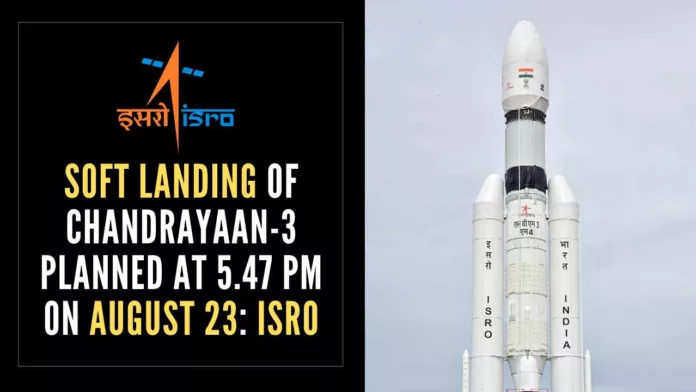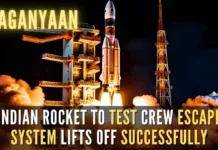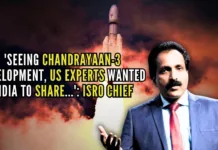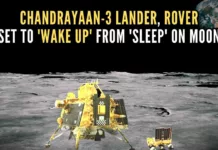
Chandrayaan-3 spacecraft on its way to moon, soft landing planned on August 23
India’s third moon mission Chandrayaan-3 will attempt the technically challenging soft landing on the lunar surface on August 23, ISRO Chairman S Somanath said on Friday. Addressing reporters after the successful launch of the estimated Rs.600 crore mission, Somanath said the craft’s insertion into the lunar orbit has been planned from August 1. The soft landing was planned at 5.47 pm on August 23, more than a month after Chandrayaan 3 took off from the spaceport here piggybacking on the heavy-lift LVM3-M4 rocket, he added.
Elaborating, Somanath said the rocket, following Friday’s launch would be proceeding towards the lunar orbit in elliptical orbits. “We are expecting it to enter into lunar orbit by August 1 and two-three weeks from then, the separation of the propulsion module and lander module will happen on August 17. The final descent is currently planned for August 23, at 5.47 pm IST. That is the plan if it goes as per the schedule” he said.
To a query on the ‘delay’ over the launch of today’s mission, as Chandrayaan 2 was launched in 2019, Somanath said it took a year to study on what went wrong in the previous mission. “Second step is what corrections are required to make it better and then we looked at what more can go wrong; will there be any hidden problems and we got that after doing the review and in the third year, we conducted testing and the final year was (about) assembling the LVM3-M4 rocket. It has been a big team comprising thousands of people for what has happened today”, he said.
On the reasons why the south pole has been selected for performing scientific experiments in the current mission, he said, “We are aiming for all the geophysical, chemical characteristics on the surface of the moon. Second, the study of the south pole has still not been explored.” Besides, nobody has conducted the thermal characteristics on the surface of the moon which ISRO would be doing in this mission, he added.
To another query, he said scientists undertook several modifications in the LVM3-M4 rocket, which included bringing down the number of engines to 4, as against its predecessor’s 5. “This was done to reduce the weight of the vehicle,” he said. On the project cost of the Chandrayaan-3 mission, Minister of State for Science and Technology Jitendra Singh said, “It was around Rs.600 crore.”
Echoing the Centre’s initiative on the Atmanirbhar Bharat campaign, Singh said Prime Minister Narendra Modi has been showing his individual interest in developing this space ecosystem in the last four-five years. “He has unlocked the doors of Sriharikota for developing space technology, and for the private sector also,” he said.
He said hundreds of startups were coordinating with ISRO in support of the development of the space ecosystem. Observing that space technology has entered every household in the country, he said efforts like telemedicine and even the supply of vaccines during COVID-19 enforced lockdown was done using it. “Now, the world is looking at us (India) to take the lead in space technology,” Singh said.
India was not what it was 10 years ago and today it was on par with developed countries like the United States, he said. “Chandrayaan-3 launch is the reiteration of our scientific prowess and technology-driven economy which is going to happen in the next 25 years. I think India is going to be the torchbearer of that,” he said.
He said that during the recent US visit of PM Modi, there was the international space station agreement as well “which in fact is the reiteration of the fact that the United States and other countries look up to India as equal partners,” he said. “It is the US which is soliciting an Indian astronaut to go up to the International space station. It is a matter of pride and a great tribute to our scientific talent,” he said.
The Chandrayaan-3 which aims for a soft landing on the moon’s surface, paving the way for future interplanetary missions, carries six payloads that would help ISRO understand the lunar soil and also get the blue planet’s photographs from the lunar orbit. The payloads, which include RAMBHA and ILSA, would perform a series of path-breaking experiments during the 14-day mission. They would study the moon’s atmosphere and dig the surface to understand its mineral composition.
Lunar lander Vikram will click photos of the rover Pragyaan as it studies the seismic activity on the moon by dropping some instruments. Using laser beams, it would try to melt a piece of the lunar surface — the regolith — to study the gases emitted during the process. The third lunar expedition in 15 years — Chandrayaan-3 — started its journey toward the moon from Sriharikota on Friday afternoon and is expected to reach the lunar orbit on August 5. It will attempt to land on the moon on August 23 evening.
“We know the moon does not have any atmosphere. But this is not exactly true because gases do come out of it. Rather they get ionized and stay very close to the surface. This changes with day and night,” ISRO Chairman S Somanath told PTI. The Radio Anatomy of Moon Bound Hypersensitive Ionosphere and Atmosphere (RAMBHA) on the lander will measure the near-surface plasma density and its changes with time. The rover will study how this small atmosphere, atomic atmosphere, and the charged particles vary, Somanath said.
[with PTI inputs]
PGurus is now on Telegram. Click here to join our channel and stay updated with all the latest news and views
For all the latest updates, download PGurus App.
- Amit Shah’s doctored video case: Delhi Police summons Telangana CM Revanth Reddy, other Congress leaders - April 29, 2024
- Smriti Irani files nomination from crucial Amethi seat; holds massive roadshow ahead of filing her nomination papers - April 29, 2024
- CISF personnel to be deployed at ED offices amid growing security concerns - April 29, 2024










